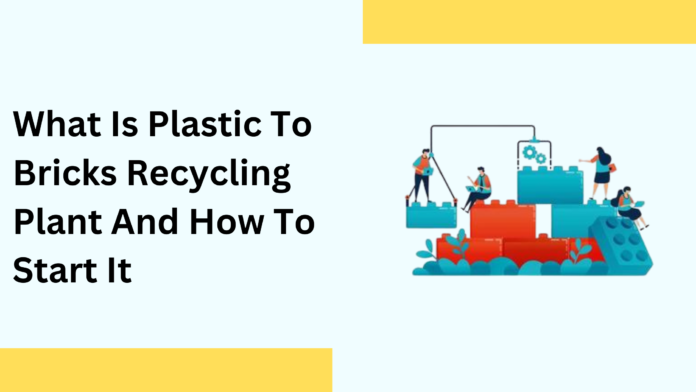What is Plastic To Bricks Recycling
A plastic-to-bricks recycling plant converts plastic waste into building bricks. The process involves melting down plastic waste and molding it into brick shapes, which can then be used for construction purposes. This type of recycling helps reduce plastic waste in the environment and provides a sustainable solution for building materials.
How To Start Plastic To Bricks Recycling Plant
Starting a plastic-to-bricks recycling plant involves the following steps:
- Conduct research: Study the market demand for plastic bricks, the available technologies, and the regulatory requirements.
- Create a business plan: Outline the goals, budget, marketing strategy, and operational plan for the plant.
- Obtain financing: Look for investors, apply for loans, or seek grants to fund the project.
- Select a location: Choose a suitable site with adequate space, access to raw materials, and proper zoning.
- Purchase equipment: Acquire the necessary machinery, such as melting and molding machines, to process the plastic.
- Hire staff: Recruit a team of employees with the skills and experience required to run the plant.
- Establish partnerships: Build relationships with local waste management companies and suppliers of plastic waste.
- Launch operations: Begin collecting, processing, and selling plastic bricks to customers.
- Continuously improve: Regularly assess the plant’s performance and make improvements to increase efficiency and profitability.
Conduct Research
To conduct research for starting a plastic-to-bricks recycling plant, you can:
- Study market demand: Assess the demand for plastic bricks in the construction industry and the target market for your products.
- Research technology: Look into the available technologies for processing plastic waste into bricks, including the types of machines, energy requirements, and costs.
- Analyze competition: Identify existing players in the plastic-to-bricks recycling industry and analyze their strengths and weaknesses.
- Evaluate regulations: Determine the local, state, and federal regulations related to plastic waste recycling and plastic product manufacturing.
- Collect data: Gather information on the sources of plastic waste, the cost of raw materials, and the pricing and demand for plastic bricks.
- Consult experts: Seek advice from experienced professionals in the waste management, recycling, and construction industries.
By conducting thorough research, you can get a better understanding of the industry and make informed decisions when starting your plastic-to-bricks recycling plant.
Create a business plan
To create a business plan for a plastic-to-bricks recycling plant, you should include the following key elements:
- Executive Summary: A brief overview of the business, its goals, and the products and services offered.
- Market Analysis: A detailed analysis of the demand for plastic bricks, the target market, and the competition.
- Products and Services: A description of the plastic-to-bricks recycling process, the types of bricks produced, and the uses and benefits of the product.
- Marketing and Sales Strategy: A plan for promoting the plastic bricks, identifying potential customers, and generating sales.
- Operations Plan: An outline of the resources and processes required to collect, process, and sell plastic bricks.
- Financial Plan: Projections of revenue, expenses, and profits, along with a detailed budget for starting and operating the plant.
- Management Team: A description of the team members, their roles and responsibilities, and their qualifications.
- Financials: A comprehensive financial analysis, including balance sheets, cash flow statements, and income projections.
By creating a comprehensive business plan, you can communicate your vision and strategy for the plastic-to-bricks recycling plant, attract investors and partners, and guide the development and success of the business.
Obtain financing
To obtain financing for a plastic-to-bricks recycling plant, you can consider the following options:
- Investors: Look for investors who are interested in supporting environmentally-friendly businesses and can provide capital in exchange for a share of the profits.
- Loans: Apply for loans from banks, credit unions, or government agencies to fund the startup and operational costs of the plant.
- Grants: Research and apply for grants offered by government agencies, non-profit organizations, or private foundations to support eco-friendly projects.
- Crowdfunding: Launch a crowdfunding campaign to raise funds from a large number of individuals who support your mission and vision.
- Partnerships: Form partnerships with companies or organizations that have the resources and expertise to help fund the project.
- Personal Savings: Use your personal savings or consider taking out a personal loan to fund the startup costs.
By exploring multiple financing options, you can find the best solution for your plastic-to-bricks recycling plant and secure the necessary funding to launch and grow the business.
Select a location
When selecting a location for a plastic-to-bricks recycling plant, you should consider the following factors:
- Access to raw materials: Look for a location that is near a source of plastic waste, such as a recycling center or landfill, to reduce transportation costs.
- Zoning laws: Make sure the location is zoned for industrial use and complies with local regulations regarding waste management and recycling.
- Infrastructure: Ensure the location has access to utilities, such as electricity, water, and transportation, to support the plant’s operations.
- Cost: Consider the cost of leasing or buying the property, including taxes, insurance, and any necessary renovations.
- Competition: Check for existing plastic-to-bricks recycling plants in the area and evaluate the potential for competition.
- Labor Market: Consider the availability of a skilled workforce in the area and the cost of labor.
- Environmental Factors: Assess the environmental conditions, such as climate, air quality, and the proximity of residential areas, to determine the potential impact on the plant and its operations.
By carefully selecting a location that meets these criteria, you can ensure the success and sustainability of your plastic-to-bricks recycling plant.
Purchase equipment
When purchasing equipment for a plastic-to-bricks recycling plant, you should consider the following factors:
- Equipment type: Research the various types of equipment available for processing plastic waste into bricks and choose the most appropriate for your plant.
- Capacity: Determine the production capacity you require and select equipment that can meet your needs.
- Quality: Look for equipment that is durable, efficient, and reliable to minimize maintenance costs and maximize productivity.
- Energy efficiency: Consider the energy requirements of the equipment and choose models that are energy-efficient to reduce operating costs.
- Cost: Evaluate the cost of purchasing and operating the equipment and compare options to find the best value.
- Service and support: Choose equipment from a reputable manufacturer with a good track record of customer service and support.
- Maintenance: Consider the cost of maintenance and repair, and choose equipment that is easy to maintain.
By considering these factors, you can purchase the right equipment for your plastic-to-bricks recycling plant and ensure its success and profitability.
Hire staff
When hiring staff for a plastic-to-bricks recycling plant, you should consider the following factors:
- Skills and experience: Look for candidates with the skills and experience required for the roles you need to fill, such as machinery operation, waste management, and quality control.
- Attitude and values: Hire individuals who share your commitment to sustainability and the environment, and who have a positive attitude towards work.
- Training: Consider the training needs of your employees and plan for providing the necessary training to ensure their success on the job.
- Cost: Evaluate the cost of hiring, including salaries, benefits, and training expenses, and balance these costs against the potential benefits to the business.
- Diversity: Encourage a diverse workforce by considering candidates from different backgrounds, experiences, and perspectives.
- Legal Compliance: Ensure that all hires comply with labor laws, including minimum wage requirements and equal employment opportunities.
By hiring the right staff, you can ensure the success and efficiency of your plastic-to-bricks recycling plant and create a positive work environment.
Establish Partnerships
Establishing partnerships can be beneficial for a plastic-to-bricks recycling plant in several ways, including:
- Suppliers: Form partnerships with plastic waste suppliers, such as recycling centers and waste management companies, to ensure a steady supply of raw materials.
- Customers: Build relationships with companies and organizations that use bricks in their operations, such as construction firms, and negotiate mutually beneficial deals.
- Community: Partner with local organizations and governments to promote sustainability and waste reduction in the community, and to educate the public about the benefits of recycling.
- Industry associations: Join industry associations and participate in events and activities to network with other recycling companies and stay informed about the latest developments in the industry.
- Technical experts: Partner with technical experts and consultants to gain access to expertise and resources that can help improve your operations and increase efficiency.
By forming strategic partnerships, you can improve the success and growth of your plastic-to-bricks recycling plant and contribute to a more sustainable future.
Launch operations
To launch operations for a plastic-to-bricks recycling plant, you should take the following steps:
- Test equipment: Test the equipment and systems to ensure they are functioning correctly and that the plant is ready for production.
- Train staff: Provide training to the staff on the operation of the equipment, safety procedures, and quality control processes.
- Obtain licenses and permits: Obtain the necessary licenses and permits from local and national authorities to legally operate the plant.
- Develop processes and procedures: Develop clear and concise processes and procedures for all aspects of the plant’s operations, including waste management, production, and quality control.
- Market the product: Develop a marketing plan to promote the bricks produced by the plant, including product features and benefits, target markets, and pricing strategies.
- Establish safety protocols: Establish safety protocols to ensure the safety of employees and the public and comply with local regulations.
- Start operations: Launch the plant’s operations, monitor production, and refine processes as needed to improve efficiency and quality.
By taking these steps, you can successfully launch operations for your plastic-to-bricks recycling plant and begin making a positive impact on the environment.
Continuously improve
To continuously improve a plastic-to-bricks recycling plant, you should regularly evaluate and update the following areas:
- Equipment performance: Monitor the performance of the equipment and make upgrades or repairs as needed to improve efficiency and production.
- Waste management processes: Regularly evaluate the waste management processes to ensure that waste is being processed in an environmentally responsible manner and that the quality of the bricks produced is consistent.
- Employee training: Provide ongoing training to employees to keep them informed of changes in the industry and to develop their skills.
- Customer feedback: Seek feedback from customers and use it to improve the quality of the bricks and to make changes to the plant’s operations as needed.
- Health and safety: Regularly evaluate the health and safety protocols in place and make changes as necessary to protect employees and the public.
- Environmental impact: Evaluate the environmental impact of the plant’s operations and implement changes to reduce waste, conserve resources, and minimize the carbon footprint.
By continuously improving the plant’s operations, you can ensure the success and longevity of your plastic-to-bricks recycling plant and contribute to a more sustainable future.





